We arrived in Johannesburg at 7:30
a.m. on 22nd September 2002. There was no time difference between Germany
and South Africa, so apart from a night with hardly any sleep for me there
was no jetlag. After clearing passport control and customs we picked up
our rental car (Budget which we had booked via the ADAC travel agency as
they offered the most comprehensive insurance) and headed east on the N12.
We stopped for lunch at a roadside place next to a little lake and had
fresh trout for only 10 euros (100 South African rand at the current rate
of 1:10) for the whole meal for both of us, 10% tip included. We couldn’t
believe at first how cheap it was! Here in Germany we couldn’t get more
than two starters plus soft drinks for that price! With the N12 and N4
being toll roads, we paid 23 plus another 38 rand (2.30 and 3.80 euros)
for this first part of our journey. We left out the open-air museum at
Botshabelo Mission in Middelburg and drove as far as the village of Waterval-Boven
where we arrived around 1 p.m. With the
Shamrock
Arms, an Irish Pub and B&B owned by Kevin who emigrated from Ireland
36 years ago and Lyn, we found a nice and inexpensive place to stay for
the first night in SA (the double room was 290 rand/29 euros). After a
little rest we visited the nearby Elands Falls. A strange African guy asked
for 20 rand for a guide and as a parking fee, but as this seemed a bit
improper to us and we were hardly able to understand a word of his English,
we didn’t pay. We weren’t really sure where to find the falls, but after
a walk through a pitch-black tunnel we came across a tour group with a
guide. Then, on the other side of the tunnel we finally saw the waterfall.
At 7 p.m. we got a nice buffet dinner at the Shamrock Arms restaurant for
only 4 euros each. We were advised by Kevin better not to leave ANYTHING
in the car at night.
Day 2: Waterval Boven – Long Tom
Pass - Sabie
The following day we travelled through
the town of Lydenburg and over the Long Tom Pass (approx. 2,000 m; named
after cannons dating from the Anglo-Boer War) to
Sabie.
As 24th September was a national holiday in South Africa we had made an
advance reservation at Wayfarers
Guest House (37 euros per night for a large double room) via the internet.
We had tried Villa Ticino (owned
by Ute and Felix from Switzerland and within walking distance from the
restaurants in the town centre) first, as they were recommended in a travel
report I had come across on the web. But as they were already fully booked
for the first of the two nights, they asked us to check at Wayfarers instead.
Our hosts there were Sergio from Italy and Lynette. Sergio was ready at
hand with tips about the nearby waterfalls and other attractions of the
region. As an artist he makes sculptures and very nice paintings of animals
native to Africa, which can be bought as a souvenir. We went to see the
Bridal Veils Falls (at the end of a long dirt road plus 15 min. hike, not
very spectacular, maybe more impressive in the rain season, 5 rand/0.50
euros fee) and the Lone Creek Falls (10 rand fee; definitely worth seeing).
We left out the Horseshoe Falls, which - according to Sergio and the already
mentioned internet travelogue - are comparatively uninteresting. Back in
Sabie we bought a chicken and mushroom pie for a picnic lunch at MacMac
Pools. This is an official picnic site (10 rand). You can hike along a
nature trail and take a bath in the cold water of the natural pools. After
our lunch break we visited MacMac Falls (5 rand), their name deriving from
Scottish gold diggers. Sergio and Lynette’s restaurant recommendation for
dinner was “The Wild Fig Tree”. We tried their crocodile strips and warthog
saddle, which were very good. Those two dishes were the more expensive
ones on the menu, but still they only cost us 8 euros each. A glass of
red wine was 0.90 euros (9 rand).
Day 3: Panorama Route – Blyde River
Canyon – Pilgrim’s Rest
The day afterwards we travelled the
Panorama Route, and after passing through Graskop we stopped off at the
viewing points The Pinnacle and God’s Window. At the latter a short trail
is leading up through a bit of rain forest, which eventually opens up to
a fantastic view overlooking the savannah. Afterwards we drove on to Wonder
View, Lowvled View and finally The Three Rondavels View, which is the most
spectacular. We went down to Aventuura Blydepoort Resort where we hiked
the 2 km long Tufa Trail (permit 10 rand per person) following a little
river. Along the way we saw a few baboons and a waterfall. As it was a
hot day with temperatures of about 30°C, we were glad when we had finally
climbed back up to the camp along a winding shadow less road with a view
of the Three Rondavels. We paid another 10 rand each at Bourke’s Luck Potholes
on our way back to Graskop, but the view of the washed out holes in the
river was worth it. Berlin Falls could – surprisingly – be seen for free.
The historical Pilgrim’s Rest, an old mining village, turned out to be
very touristy and a lot of children were playing in the street asking for
money, so we didn’t stay long. Back in Sabie the “Country Kitchen” (which
obviously has a good reputation) was closed after the holiday weekend.
So we ended up at the “Loggerhead Restaurant” where we had trout, wine
and deep-fried ice-cream for dessert, everything for 160 rand incl. tip.
|
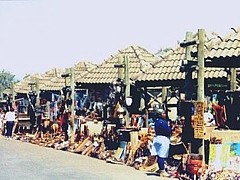
|
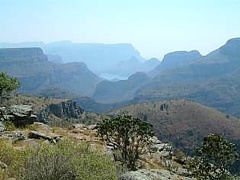
|
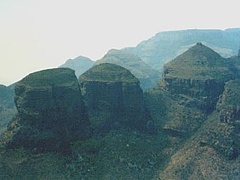
|
|
Souvenir Stalls near God's Window |
Blyde River Canyon |
The Three Rondavels |
|
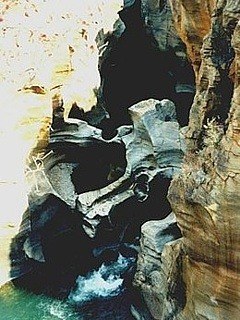
|
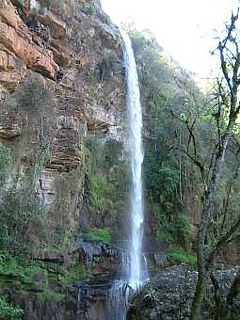
|
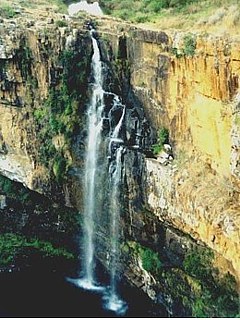
|
|
Bourke's Luck Potholes |
Lone Creek Falls |
Berlin Falls |
Day 4: Sabie – Kruger National Park
On Wednesday, 25th September, we
drove from Sabie – via Hazyview where my manager Birgit recommends
Shingala
Guest House, where she stayed during her trip to SA two years ago –
to Paul Kruger Gate and entered the Kruger National Park (admission charge
3 euros p.p. plus 2.40 euros per car). The first animal we saw, a giraffe,
was spotted by Volker. Then we saw a herd of impalas and I spotted our
first elephant. We also saw baboons, warthogs, wildebeest, zebras and marabous.
Right after we stopped at a watering hole a group of elephants was approaching
to drink. We took quite a few pictures. It was amazing to see the animals
in their natural habitat! Two giraffes were also close by. Then we continued
on our way, discussing how difficult it must be to spot a lion in the tall
grass. Not long afterwards we saw a car standing by the roadside and of
course we went to see if they had seen anything exiting. And there they
were, right next to the road, a male and female lion, snoring in the grass
under a tree! After having taken their pictures the other car moved on
and we advanced into their position to get a better look. Suddenly the
male lion opened his eyes, got up, stepped behind the female – and we could
hardly believe our eyes that we had the chance to watch them having sex
from a first rate position!! The whole affair didn’t last long, but we
were able to get some great shots of the pair! And these were only our first 100 kilometres in the park! Not long afterwards
we reached Camp Satara and checked into our bungalow (37.50 euros per night).
A camp employee showed us a tiny owl perched on a tree; so cute! We were
back on the road again by 5 p.m. to watch the sunset and maybe see some
night-active animals. We weren’t very lucky with animal sightings this
time, but eventually we saw a fish eagle catching and eating a fish right
before our eyes. The sunset was glorious with the sun a fiery red ball
on the horizon. Unfortunately we couldn’t stay to watch till the end as
we had to be back at the camp before they close the gates at 6 p.m. At
the camp shop we had bought kudu (antelope) steak for a braai (South-African
barbecue), which we set about to grill in front of our hut. But the charcoal
was only burning very slowly. A South-African family from our neighbouring
hut helped us out with some wood, which quickly produced a lovely fire,
and they asked us to share some of their food: broerewors (a local sausage
speciality) and salad! This was really nice of them!
Day 5: Kruger National Park
In the morning of 26th September
it looked like almost everybody had departed the camp with the first morning
light and as soon as the gates opened at 6 a.m. It is said the best time
to see animals in the wild is at sunrise or at dusk. Volker and I didn’t
get up before 7:30 a.m. however (we aren’t really early risers), and but
nevertheless after breakfast we were pretty soon face to face with a couple
of elephants! They were so close it was almost scary in case they might
feel threatened and attack. But eventually they just trotted off. We also
saw giraffes, zebras, wildebeest, waterbucks, monkeys, impalas, a warthog,
etc. When we arrived at Camp Olifants around 1:30 p.m. we were allocated
the bungalow (37.50 euros per night) with the best river view of the entire
camp, and we immediately saw a couple of elephants crossing the shallow
water! With the rain season only starting in October, the river didn’t
hold much water. From time to time other guests came to stand in front
of our hut to admire the view. An official viewing point can be found adjoining
the camp shop and restaurant, with a view of the other side of the river.
We went to the reception to ask for places on the night drive for the following
day, but unfortunately it was already fully booked. We could have obtained
seats on the morning drive, but that didn’t really appeal to us as for
nocturnal animals the evening hours seemed more promising. In order to
watch the sunset and maybe catch a glimpse of some more animals at dusk,
we left the camp at 4:30 p.m., but once again we weren’t very fortunate
with animal sightings at that time of day. Back at our hut we put some
beef steaks on the braai grill, but we didn’t linger outside, as a lot
of insects were attracted by the light from the hut. I didn’t see or –
luckily – feel any mosquitoes though! But just in case we always sprayed ourselves with a lot of insect spray
in the evening. Besides we had taken the prophylactic. It’s always better
to be safe than sorry!
Day 6: Kruger National Park
That morning, 27th September, we
tried to do our own morning drive, getting up at 5:30 a.m., after being
woken up anyway by the sound of hippos roaring. Sounded much like lions.
Breakfast at the hut was not much fun as the floor was strewn with dead
insects from last night! We left the camp around 6:30 a.m., but no extraordinary
animals were to be seen (not even many at all). We drove along an untarred
road for a little over three hours. Along the way we saw some impalas as
usual and eventually, getting close to Camp Letaba, a larger group of elephants
right next to the road munching away at the trees. It’s amazing how much
havoc elephants can wreak! It looked like a storm had been ravaging the
area! For second breakfast we had a coffee and muffin on the terrace at
Camp Letaba, overlooking the Letaba River. We had a look at the camp’s
Elephant Hall, a small museum telling about the history of elephants in
Kruger Park. Driving further north afterwards we saw some more elephants
at first, more impalas of course, but for longer stretches nothing much
at all. Later a few giraffes crossed our route and eventually we spotted
a 3-legged Nile monitor (Nilwaran) about to cross the road. Near the turn
to Camp Olifants some hippos were bathing in a pool in the riverbed. Some
more of them were lying on a sandbar. Unfortunately we couldn’t get a very
good view of them as the best viewing spot was already occupied by another
car. All in all we did 200 kilometres in 9 hours that day. The average
speed in Kruger Park is only approximately 20 km/h. Sitting on the porch
of our river view hut around 5 p.m., we saw a group of 20 elephants crossing
the Olifants River in one long line! We bought some more braai meat and
we had just placed it on the grill in front of our hut, when the downpour
started! That entire day the sky had never turned really blue and the first
raindrops came down at the end of our day tour when we were already heading
back to the camp. During the night there was a raging thunderstorm.
Day 7: Kruger National Park
On 28th September we drove from Camp
Olifants via Satara to Lower Sabie. On the way we came across giraffes,
wildebeest, zebras, elephants, impalas, kudus, warthogs, hippos, crocodiles,
marabous, guinea-fowl, a large owl, and we even caught a glimpse of a leopard
disappearing up a tree. Upon arrival at Lower Sabie (35 euros p.n.) we
jumped into their pool for a quick swim. Unfortunately all the river view
bungalows were already fully booked when we had made the reservation in
January! We watched the spectacular sunset at sunset pool a few minutes
from the camp and had a buffet dinner at the camp restaurant for 8 euros
(80 rand) per person, which was comparatively expensive and not particularly
good. A bottle of wine was 4.80 euros; a bottle of 0.5 l water 0.60 euros.
The service was a bit unnerving as they kept asking whether we had already
finished, which gave us the strong impression that they wanted to get rid
of us as soon as possible to make room for the next guests!
Looking back at our stay in Kruger
Park we didn’t really see more animals during the early morning hours,
or before sunset, than during the day and neither did we see more animals
on dirt roads than on the main roads. We actually had more sightings on
the main roads I believe. Maybe it’s because the car makes less noise on
the tar? We spent four nights at Kruger Park, which gave us ample time
to drive around and watch out for animals. Two nights should be the minimum
as the park is as equal in size to Belgium! It was pretty exciting to go
on “animal hunt” with our cameras every day, and as you are not allowed
to exceed 40 km/h in the park and you keep stopping to watch the animals,
it’s impossible to cover long distances! The landscape in winter is not
very pretty as there isn’t much foliage, but for the same reason it’s easier
to spot the animals. And as there isn’t much rain in winter the animals
tend to gather around the water holes more often.
Day 8: Kruger National Park – Nelspruit
– Kaapsehoop – Johannesburg Airport
The following morning we woke up
around 6 a.m. We had a buffet breakfast at the camp (4.50 euros p.p.).
It was okay but not great. We left the camp around 8 a.m. and we saw some
more impalas, giraffes, kudus, waterbuck, elephants and finally we were
lucky to spot two rhinos, obviously mother and child! Now we had seen Africa’s
Big Five (elephant, lion, buffalo, rhino, and leopard). In a riverbed –
in the distance – we also spotted a lioness with her cubs! After another
100 kilometres we reached Malelane Gate and left the park around 11:30
a.m. We passed through Nelspruit, the largest city in the region, but unfortunately
we didn’t see much of the blooming Jacaranda trees. Then we went up an
old passes road to Kaapsehoop, a former gold-mining village. Wild horses
live in the area and you can go for a 1-hour hike around the rocky area
in close proximity to the town. It was 1 p.m. when we stopped for lunch
at the Pancake House. Volker opted for a filled pancake, while I chose
a toasted sandwich and we both had a large milkshake all for 6.60 euros
incl. tip. We reached Johannesburg airport shortly before 5 p.m. and checked
into our pre-booked room at the
City
Lodge Airport Hotel (43 euros per double room excl. breakfast). At
first we were unable to find the way to the hotel as we had forgotten to
print the directions from the website, but a friendly black guy told us
to follow him in his car when we asked around at a petrol station. We were
wondering if this was a wise move, but he took us back along the motorway
and to another exit, where he jumped out of his car to give us some final
directions. We gave him 10 rand for a tip, and the hotel was just around
the corner. For safety reasons, as recommended by the hotel, we took the
car to go for a steak dinner at a grill house across the road (16.80 euros
plus tip).
During this first part of our journey
we covered 1900 kilometres.
Day 9: Cape Town (Kirstenbosch Botanical
Gardens, Groot Constantia)
30th September started off as a grey
day and we left the hotel early to catch our South-African Airlines flight
scheduled for 8:35 a.m. Upon arrival at the airport we were able to get
onto an even earlier flight leaving at 8 a.m. We arrived in Cape Town two
hours later with the table mountain in full view beneath a clear blue sky.
We had booked three nights at
Britford
House B&B (36.50 euros per night for the double room) in Seapoint,
located in a side street off the Seapoint promenade. We got there around
11:30 a.m. and were let in by Princess who showed us around the house and
explained to us how to lock which doors. Most houses in Cape Town seem
to have extensive security systems due to the rising criminality. We refreshed
ourselves and decided to profit from the good visibility and go up the
Table Mountain right away. By the time we left the house no more than 30
minutes later we found the sky completely overcast! With the surrounding
mountains disappearing in the clouds we quickly changed our plans and visited
Kirstenbosch Botanical Gardens (1.50 euros p.p.) instead. Just in case
we took along our rain coats. We had a pancake lunch at the restaurant
on the premises (6.80 euros plus tip) and we were just about done with
our tour of the beautiful gardens when it started to rain. By the time
we got back into the car and headed towards Groot Constantia, which wasn’t
far off, the rain came down in a heavy downpour! The manor house of this
wine estate is a typical example of colonial Cape-Dutch architecture. It
made no sense to sit and wait in the car as there seemed no end to the
rain, so we jumped out quickly and ran down the avenue towards the manor
house
and museum. Because of the torrential rain there was no point in walking
along the grounds so we decided to visit the museum (0.80 euros each),
which showed some antique furniture in the old manor house. We got pretty
soaked on the way back to the car and decided to return to Britford House.
In the evening the sun came out again. We went to the Victoria and Alfred
Waterfront for a light dinner at a café (9 euros incl. tip) and
strolled a bit through the mall. The V&A Waterfront is said to be pretty
safe at night, so we rather went there than to the city centre.
Day 10: Cape Town (Table Mountain,
V&A Waterfront, Bloubergstrand)
Breakfast the next morning was prepared
for us by Joyce. We still hadn’t met our host who used to have his office
in Britford House but visits now only infrequently. Even though it was
still cloudy we decided to go up the
Table
Mountain as long as visibility was still said to be good (there’s a
phone number you can call). We went up by cable car (8.50 euros return
each) around 10:15 a.m. (the only other way to get there is on foot but
due to the steep long climb this is not generally recommended) and arrived
on top in less than 5 minutes – just when a solid blanket of cloud was
moving over the mountain top! Well, we started to walk around a bit in
the mist, but apart from the fynbos vegetation growing on the rocky surface
and a few rock dassies (Klippschliefer) nothing much could be seen. We
had a look into the souvenir shop and went to sit in the restaurant for
a hot chocolate for an hour. By 11:45 a.m. we were just about to give up
and start our descent, when the sun suddenly came out again! So we walked
around a bit more, admired the views through the breaks in the clouds and
took pictures of Cape Town below. When we got back down, we drove to Signal
Hill and took pictures of the Table Mountain rising above Cape Town. The
sky was still grey. After lunch at a pancake place on the V&A Waterfront
we walked around the harbour area in the by now beautiful sunshine. A few
seals could be seen lying around on a platform. We decided to drive to
Bloubergstrand, north of town, which offers beautiful views of Cape Town
and the Table Mountain. Took more pictures. Eventually we headed back to
Seapoint and enjoyed the setting sun from the beach promenade for a little
while. Due to the continuous breeze it didn’t feel too warm though, so
we finally returned to our accommodation. If it weren’t for a German/South-African
couple who are frequent guests at Britford House, we wouldn’t have learnt
much about local life in Cape Town. Besides relating some of their experiences,
they gave us the one or other dinner recommendation like “Mama Africa”
in Long Street or “Café Africa”, but we still didn’t feel very safe
driving into town at night. Instead we went for dinner at a Portuguese
restaurant on the Waterfront (13 euros incl. tip).
|
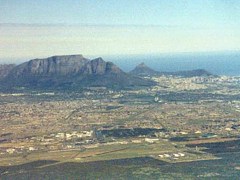
|
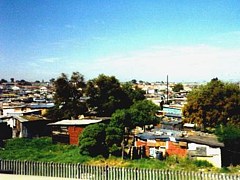
|
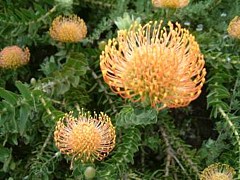
|
|
Cape Town and Table Mountain |
Slums in Cape Town |
Protea at Kirstenbosch Botanical Gardens |
|
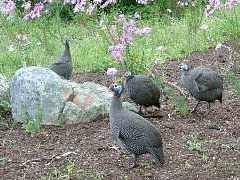
Guinea Fowl at Kirstenbosch
|
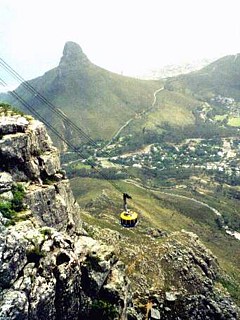
|
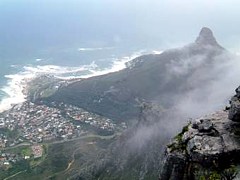
View from the Table Mountain
|
|
|
Cable Car |
|
|
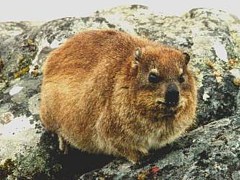
|
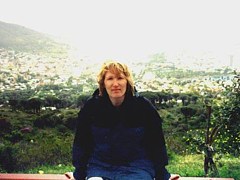
|
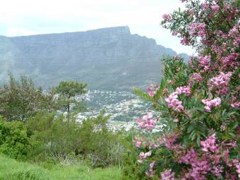
|
|
Rock Dassy |
Katja |
Table Mountain |
|
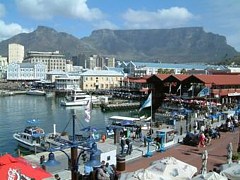
Waterfront, Cape Town
|
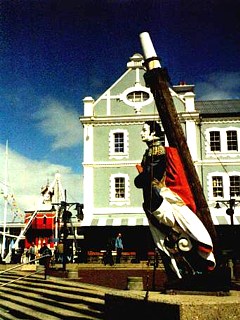
|
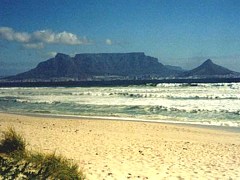
Bloubergstrand
|
| |
Waterfront, Cape Town |
|
Day 11: Cape Peninsula
That morning, 2nd October, we finally
met our host Michael who turned up during breakfast. We left Britford House
around 9:30 a.m. for the Cape Peninsula. We drove down to Hout Bay and
along Chapman’s Peak Drive, at least as far as we were able to. This panoramic
coastal road has been closed for the last couple of years due to a rockslide,
which washed away part of the road. After a few kilometres you get to a
viewpoint. At the roadblock we had to turn back and pass through Constantia
again in order to get to Fish Hoek and Simon’s Town. After a large milkshake
in a café on Jubilee Square – here stands the statue of a member
of the Royal Navy in WWII the dog Able Seaman Just Nuisance! – we visited
the penguin colony on Boulders and Foxy Beach (1 euro p.p.). After watching
the cute little birds we continued on our way to
Cape
Peninsula National Park (2.5 euros p.p.) and drove down to Cape Point.
The baboons frequenting the parking area can be aggressive at times because
they are often illegally fed by tourists, but they didn’t bother us. Nevertheless
we saw them climbing on top of cars and wanting to climb into them as soon
as a door opened in search of food! Wish I had been able to catch them
on photo! We climbed up to the historic lighthouse (there’s a cable car
as well), with the Cape of Good Hope, the most south-westerly point of
Africa to our right. Up at the lighthouse it was hard not to get blown
away by the strong wind, but we were rewarded by catching a glimpse of
our first whale! We went for lunch at the Two Oceans Restaurant, which
was very busy and we had to wait to get a seat. We expected something rather
like a fast-food place, but they had a good choice (a lot of seafood) and
their service was surprisingly quick and friendly. We paid 10.50 euros
including tip for my large tuna salad and Volker’s chicken. Afterwards
we drove down to the Cape of Good Hope. Saw a wild ostrich on the way.
Then we went to Olifantsbos and walked along the shipwreck trail (approx.
1.5 hours along the beach and back) to the wreck of Thomas T. Tucker, one
of the many shipwrecks on the South-African coast, which can still be seen
lying on the beach). As it was getting late and some clouds were appearing
in the distance we didn’t linger too long and headed back to Cape Town
via Kommetje and Constantia. Bought a sandwich dinner and drinks at a supermarket
in Hout Bay so we didn’t have to go out that evening. There was a heavy
storm that night.
Day 12: Hermanus
On 3rd October we went to
Hermanus,
travelling along the coast via Strand with its long white beach, Gordon’s
Bay (saw a couple of whales from the cliff road) and Betty’s Bay with its
penguin colony at Stoney Point. Here we didn’t have to pay an admission
charge, but the penguin colony at Boulders was much more impressive. We
had heavy rain and a strong wind at first, but eventually the sun was coming
out again. We reached Hermanus around 12:30 p.m. and asked for accommodation
at the tourist information. Excellent and friendly service. They made a
reservation for us at
St.
Ives, a B&B on Westcliff Road (40 euros for the double room). We
got a beautiful large room with sea view and we could even see the whales
from our room! The cliff path, which offers excellent opportunities for
whale watching, was right across the road. We walked into town and had
a very good pasta lunch at Nino’s in Market Square. We saw some more whales
in Walker Bay. When we got back to St. Ives, our friendly English host
Peter reserved a table for us at “The Burgundy Restaurant” for 7:30 p.m.
It was the last table available there that evening! We had ostrich and
beef plus soup and wine, all for 24 euros incl. tip. That week Hermanus
was hosting the annual Whale Festival with artists, workshops and entertainment.
Day 13: De Hoop Nature Reserve –
Arniston/Waenhuiskrans
The following day, 4th October, we
went up “Rotary Drive” first, which offers fantastic views across the bay
of Hermanus. Our destination that day was the De Hoop Nature Reserve. We
left the coastline but the road to Bredasdorp through a green hilly landscape
was also very pretty. We dropped by the tourist information and asked them
to make a reservation for us at
Arniston
Lodge, which I had come across in a travelogue on the internet. We
got their last room for 35 euros the double room. After Bredasdorp it’s
another 50 kilometres via an untarred road, then from Wydgelée/IOuplaas
another 10 kilometres into De Hoop (1.50 euros p.p.). The Circular Drive
and De Mond Drive are not really worth the time and effort of driving along
untarred roads. In the Game Viewing Area near the centre of the park we
saw ostriches, bontebok and mountain zebra and a turtle crossed our way
as well. Finally we arrived at the white sand dunes at Koppie Alleen (Long
Beach). The sun was shining, but there was a strong wind. We went to sit
in the shelter of some rocks above the waves and watched the whales rolling
in the surf. Eventually we even saw a whale breaching a couple of times
in the distance! We went to Arniston,
also known as Waenhuiskrans, via Bredasdorp and checked into our room.
While sipping some wine at the house bar, our host Erwin, who emigrated
40 years ago from Bavaria, told us about his experiences in South Africa.
Soon it was time to go for dinner. There are only two restaurants in Arniston,
which is only a small fishing village, one at the “Arniston Hotel” and
one called “Waenhuis”. We chose the latter and without having made a reservation
we managed to get one of the last free tables. We had butterfish and salad
for 15 euros incl. tip. Erwin said it was safe to walk the 10 minutes,
but in the dark we preferred to go by car.
Day 14: Cape Agulhas, Swellendam,
Bontebok N.P.
5th October was a beautiful day again.
We went to Cape Agulhas via an untarred road from Arniston instead of passing
through Bredasdorp again. With its many bed&breakfast places overlooking
the sea Struisbaai would probably have made an excellent overnight stop
as well. In L’Agulhas we drove out to the southernmost tip of Africa (marked
by a stone monument), where the Atlantic meets the Indian Ocean. We visited
the lighthouse museum, which shows photographs from lighthouses all over
the world. You can also climb up to the top of the lighthouse, where you
have to be careful not to get blown away by the strong wind! Afterwards
we had a café latte in the adjoining coffee shop. Our next stop
was Swellendam, the third oldest
town in the country. On Saturday afternoon when we arrived, the tourist
information was already closed for the weekend, but I had found a recommendation
in an internet travelogue for Old Thatch
Lodge. We got an entire cottage with self-catering facilities for only
28 euros for both of us including breakfast! After checking in we visited
the Bontebok National Park (1.50 euros p.p.). We saw bontebok only from
a distance, but they have a couple of very nice 30-minute nature walks,
which we did both. When we got back to the cottage, Chris-Maré made
a dinner reservation for us at “Mattsens”, right next to the tourist office.
We had a very good sole and steak plus salad and wine for 19.50 euros incl.
tip.
Day 15: Mossel Bay – George – Knysna
On 6th October we had breakfast on
the terrace of the main building at Old Thatch Lodge together with by another
German couple, while our German host Karin told us about her life in South
Africa. Then we left for the famous
Garden
Route, the coastal stretch between Mossel Bay and Storms River. In
Mossel Bay my manager Birgit recommends Mossel Bay Guesthouse in Bruns
Road. We visited the Old Post Office Tree and had a good and cheap lunch
at the Santos Train, which is also a back-packer accommodation. We tried
out some South-African specialities, Bobotie and Waterblommetjiebredie,
for only 11.50 euros incl. tip. In George we had a look at the Old Slave
Tree and its still visible iron chain used to tie up the slaves during
auctions. Upon arrival in Knysna we checked into
Fish
Eagle Lodge in Welbedacht Lane, overlooking the Knysna Lagoon. This
was a recommendation from our travel guidebook and the service was indeed
excellent. The place is run by a German family: Renate, Klaus and their
daughter Gelia plus Chris. We decided to stay for four nights (39 euros
per night; 45 euros for the last night in the honeymoon suite with Jacuzzi
and lagoon view). Chris presented us with a lot of information about what
to see in the area and where to go for dinner. We chose “Paquita’s” at
the Knysna Heads for the first night and he made a reservation for us for
7:30 p.m. We both had fresh line fish – mussel cracker – plus pizza bread
for 15 euros incl. tip.
Day 16: Wilderness N.P. - Knysna
On 7th October we took the old Five
Passes Road across the mountains to George. As the road is partly untarred
it took us about 1.5 hours until we reached Wilderness around 11:30 a.m.
We went straight to the Dolphin Viewpoint along the N2 at the mouth of
the Kaaimans River to see the
Outeniqua
Choo-Tjoe steam train pass over the Kaaimans River Bridge. We had to
wait half an hour for the train to appear after leaving Wilderness station.
At that time of year and during the South-African summer season two daily
trains are servicing both directions between Knysna and George, which provides
opportunities to see the train steaming over the bridge around 10 a.m.,
12 p.m., 2:30 p.m. and 4:30 p.m. The Outenique Choo-Tjoe travels along
some of the Garden Route’s most spectacular scenery, so it’s quite a shame
we didn’t make a trip on that train ourselves. We had a sandwich lunch
at “Penny Lane” in Wilderness for 5.50 euros incl. tip. Afterwards we took
off along the Half-Collared Kingfisher Hiking Trail in Wilderness National
Park, following it for about 3 km along the Touw River and Bosduif Loop.
It was quite an adventurous walk through the woods involving some climbs
up and down wooden ladders while the path was getting narrower all the
time. We turned back after about an hour and didn’t even get to see the
waterfall at the end of the trail. At one point Volker crossed the river
by canoe to pick up a couple of German hikers who were stuck on the other
side! For dinner that evening we had made a reservation at the “Dry Deck”,
overlooking Knysna’s waterfront. It’s quite a stylish place with candles
on the tables, lagoon view and an excellent service; in fact we felt it
was the best place we ate at during our holiday. We had kingklip, soup
and coffee for 22.50 euros incl. tip).
Day 17: Tsitsikamma N.P. - Knysna
For 8th October we had booked a whale-watching
cruise in Plettenberg Bay, but the tour operator phoned in the morning
to cancel the trips for that day because the sea was too rough. So we changed
our plans and went to Tsitsikamma National Park via Nature’s Valley and
the very scenic Old Passes Road (R102). We passed below the Bloukrans Bridge
with the world’s highest commercial Bungee Jump (216 m) and went to see
the Big Tree (15 min. hike from the parking lot; 1.50 euros each) along
the N2, an 800 years old Outeniqua Yellowwood. We also had a look at the
Storms River Bridge, also known as Paul Sauer Bridge, from the viewpoint
at the petrol station a bit further on along the N2. Afterwards we went
to the Storms River Mouth Restcamp in Tsitsikamma National Park (2 euros
p.p.). The buffet lunch at its restaurant was not particularly good (12
euros incl. tip), but there was no alternative, except going hungry, which
we weren’t too keen on. After lunch we hiked to the hanging bridge across
the Storms River Mouth (30 min. return trip). With the wind blowing strong
that day, the waves were breaking hard onto the rocky shore under a clear
blue sky. In mid afternoon we set off to hike the first couple of kilometres
of the Otter Trail, a famous 42 km long hiking trail along the Tsitsikamma
Coast. The sun was already low and the light shone beautifully on the waves
and the rugged windswept coast. The first fairly easy and level part of
the trail was followed by a few rather difficult passages with some not
always easy rock scrambles. So once again we didn’t get as far as the waterfall
some three kilometres along the trail, and as it was already getting pretty
late, we turned back after an hour and arrived back at the camp around
5 p.m. We returned to Knysna via the N2 (across the Bloukrans Bridge it’s
a toll road; 0.85 euros). We went for dinner at “Harry B’s” (line fish
and beef fillet with salad and soup for starters; 22 euros incl. tip).
Day 18: Whale Watching in Plettenberg
Bay - Knysna
The following morning we had to change
rooms at the Fish Eagle Lodge and moved into their honeymoon suite for
our last night. We had been able to change our reservation for the whale-watching
cruise (40 euros p.p.) by one day to give it another try. I could hardly
believe the strong wind of the day before would be followed by hardly any
wind at all! But the sky was still a beautiful blue. So after moving our
stuff we were off to Plettenberg Bay.
Ocean
Safaris had their office on Central Beach. As we arrived early for
the 12 p.m. trip, we went for a coffee at “Moby Dick’s” first. Two boats
were going out at the same time that day. With a truck pushing the boat
we got shot into the sea right from the beach, which is called a dolly
start. The boat seats 12 plus one guide and the skipper. We headed out
into the bay and pretty soon we saw a couple of Southern Right Whales (Glattwale)
from up very close (approx. 50 m). After rolling lazily about at first
one of them suddenly started breaching, meaning it lifted his entire body
out of the water in one massive leap, which was repeated several times!
Unfortunately this was just when I had to change film!! After approximately 20 minutes we shot across the bay for the seal colony
off the Robberg peninsula. A lot of seals were perched on the rocks or
lazing in the water. Sometimes sharks can be seen as well. They love seals!
We watched a little while, and then we went back across the bay towards
the beaches east of Plettenberg Bay where we saw a couple more whales in
the distance and a lot of bottle-nose dolphins playing in the surf! At
the end of two hours the boat shot back onto the beach and we descended
onto the truck. After a late lunch at “Moby Dick’s” (10 euros incl. tip)
we returned to Knysna via the passes route (R340/R339), which is untarred
for most of the way, but we were rewarded the shaky stretches with some
very pretty scenery. We took a bath in our Jacuzzi and watched the sunset
across the lagoon from our bed! We had dinner at the “Oyster Seafood Restaurant”
(run by Roland, another German immigrant). Not particularly fond of seafood,
we chose trout salad, kingklip and ostrich steak (20 euros with 10% service
charge already included).
Day 20: Oudtshoorn – Little Karoo
– Montagu
On Thursday, 10th October, we checked
out of Fish Eagle Lodge and drove to
Oudtshoorn
via the Outeniqua Pass road, where we saw another steam train crossing
the mountains in the distance. We did a tour at the
Safari
Ostrich Show Farm (1 hour at regular intervals, 3.50 euros p.p.) and
had lunch at Kentucky Fried Chicken (4.30 euros). Unfortunately we didn’t
have time to travel the Swartberg Pass and Meiringspoort Ravine north of
Oudtshoorn and to visit the Cango Caves and Cango Wildlife Ranch, which
would certainly have been worthwhile seeing. Travelling along the scenic
R62 through the Klein Karoo via Calitzdorp, Ladysmith and Barrydale we
reached the fruit and wine valley of
Montagu.
Following a recommendation from Peter of “St. Ives” we asked for a room
at Squirrels Corner B&B.
Our German hosts Iris and Gerhard bade us welcome with a glass of muscadel
wine, which is typical of the area. With the sun still shining in a blue
sky we strolled a bit through the quiet town and Iris made a reservation
for us at the “Four Oaks Restaurant” (owned by a German couple Bernd &
Monica; 26.50 euros incl. tip for one kudu carpaccio to share, springbok
medallions and lamb plus two crêpes with ice-cream). I quite regretted
that we didn’t take the time to visit the Avaloon Hot Springs.
Day 21: Franschhoek Pass – Boschendal
– Stellenbosch
On 11th October we travelled to Stellenbosch
via the wine route passing through Robertson, Worcester and
Franschhoek.
From the top of the Franschhoek Pass we had magnificent views of the Franschhoek
Valley. Franschhoek is a pretty little town and the gourmet capital of
the Cape. We passed by the Huguenot Memorial Monument and visited the wine
estates L’Ormarins (1694) and
Boschendal
(1685). We had a light lunch at the latter (10 euros) among oak trees and
surrounded by insatiable ducks. Boschendal is the oldest wine estate in
South Africa and the manor house in Cape-Dutch style can be visited. At
the Boschendal shop we bought two wine bottles to bring along for our hosts
Doris and Billy who had invited us for the following day. At
Stellenbosch,
a university town and the second oldest town in South Africa, we drove
to Wedge Farm Inn first, also recommended by Birgit, but the former guesthouse
had burnt down in a fire. So we went to the tourist information instead
and had a room arranged for us at
Blue Orange B&B
(owner: Nick; there’s
no sign outside, but a corner shop of the same name; 30 euros per night; seems
to have been extended since we were there)
in Hamman Street, a quiet dead-end street off Dorp Street in walking distance
from the town centre. We went to see the historic curios and antiques shop
Oom Samie se Winkel just around the corner in Dorpstraat, crossed the busy
Braak town square and made a dinner reservation at the “Wijnhuis” (upstairs;
corner of Andriga and Church (Kerk) Street, another recommendation from
Birgit). We visited the Dorp (Village) Museum, exhibiting four historic
Cape houses with typical furniture dating from 1709 to 1929 (1 euro each),
and surfed a bit on the internet at “Javacafé” (corner Ryneveld/Dorp
Street). Stellenbosch has some nice old buildings, but still it came a
bit short of my expectations. Maybe for a European it’s not so special.
When we returned to our accommodation afterwards, the sky had suddenly
turned cloudy. Later that evening at the “Wijnhuis” we had one tomato-mozzarella
salad, one soup and two grilled cods (kabeljou) plus wine for 28 euros
incl. tip. We went to the “De Akker” pub in Dorp Street afterwards and
had a beer and a cider. That night there was lightning and thunder again.
Day 22: Velddrift/Port Owen
On Saturday, 12th October, after
a large breakfast at the Blue Orange café, we left Stellenbosch
to drive up the west coast to Velddrift in order to visit a relative of
mine, Doris, who is my granddad’s cousin, and her English husband Billy.
Doris emigrated with her family from Germany at the end of the 1950ies
when she was about 9 years old. They used to live near Durban but have
now moved to the West Coast to enjoy live as pensioners. They have built
a house right next to the river where they keep two small boats and two
big dogs, a black Labrador and a typical African dog. I could have taken
home the Labrador, he was so cute! After a hearty welcome Doris showed
us the guestroom with its own bathroom and balcony and a sofa bed. After
we had refreshed ourselves, they gave us a little tour around
Port
Owen and Velddrift by car. We went for fish and chips from a take-away
for a late lunch and in the afternoon we went for a little walk with the
dogs. It was a bit cloudy that day, but it ended with another pretty sunset.
For dinner Doris cooked an excellent beef curry which we had together with
the wine from Boschendal.
Day 23: West Coast National Park
– Cape Town Airport
13th October was the last day of
our holiday. After breakfast Doris and Billy took us on a little boat trip
up the Great Berg River. A lot of different bird species can be seen along
the river shore: flamingos, kingfisher, herons, pelicans, cormorants, etc.
We had grilled hake for lunch, then we had to return to Cape Town. Via
Langebaan we entered the West Coast National Park (1.50 euros p.p.), which
was only a short detour. We were too late for its famous spring flower
season in August and September, but nevertheless we enjoyed the beautiful
views and the encounters with birds, ostriches and tortoises. There are
many more animals inhabiting the park, but they are usually hard to spot.
After another night flight Cape Town – London, leaving at 8:35 p.m., we
arrived back home in Düsseldorf at 1:10 p.m. on 14th October.
During this second part of our trip
we covered 2850 kilometres.
All in all we travelled about 4750
kilometres.
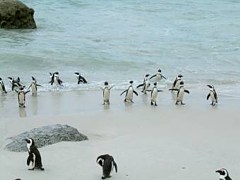
Penguin Colony, Boulder Beach |
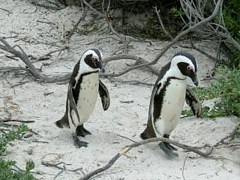
Penguin Colony, Boulder Beach
|
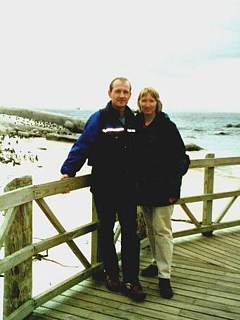
|
| |
|
At Boulder Beach |
|
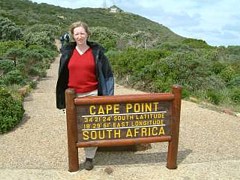
|
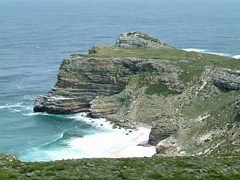
|
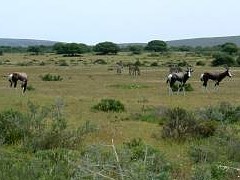
|
|
The Cape Peninsula |
Cape of Good Hope |
Bontebok at De Hoop Nature Reserve |
|
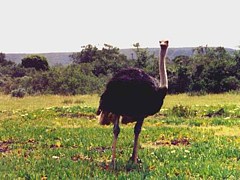
Ostrich at De Hoop Nature Reserve
|
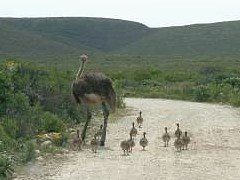
Ostrich Chicks at De Hoop
|
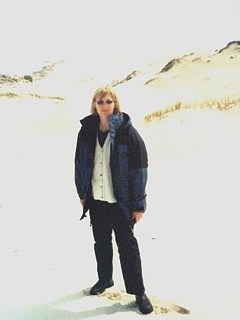
|
|
|
|
In the Sand Dunes at De Hoop |
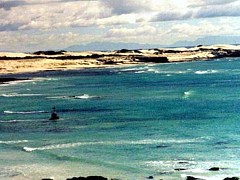 |
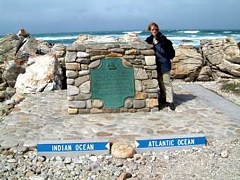 |
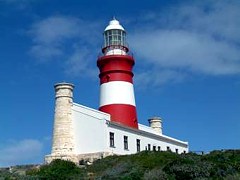 |
|
The Coast at Arniston/Waenhuiskrans |
Cape Agulhas |
Lighthouse at Cape Agulhas |
 |
 |
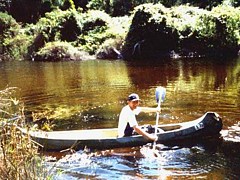 |
|
Cottage near Cape Agulhas |
Outenique Choo-Tjooe Train |
Wilderness National Park |
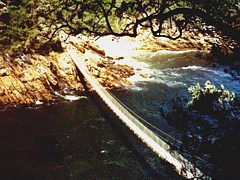 |
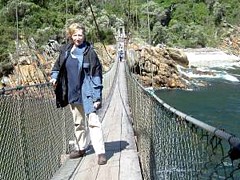 |
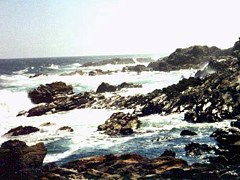 |
|
Tsitsikamma National Park |
Tsitsikamma National Park |
Tsitsikamma National Park |
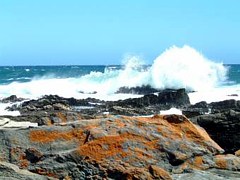 |
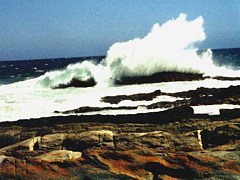 |
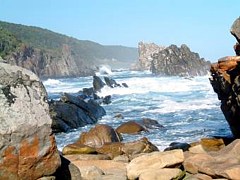 |
|
Tsitsikamma National Park |
Tsitsikamma National Park |
Tsitsikamma National Park |
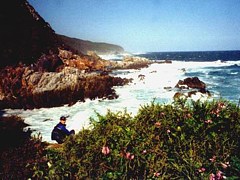 |
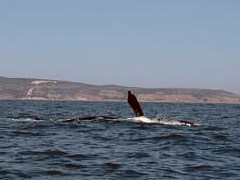 |
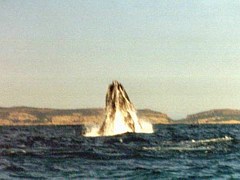 |
|
Tsitsikamma National Park |
Whale Watching |
Whale Watching |
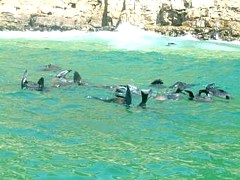 |
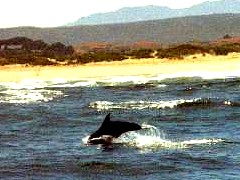 |
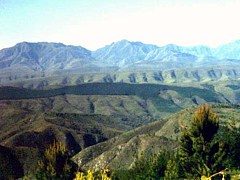 |
|
Seals |
Dolphins |
The Tsitsikamma Coast |
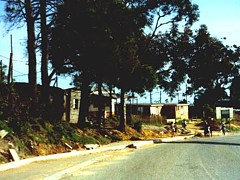 |
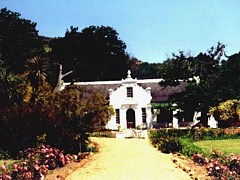 |
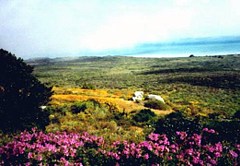 |
|
Squatter Camp |
L'Ormarins Manor |
West Coast National Park |
|
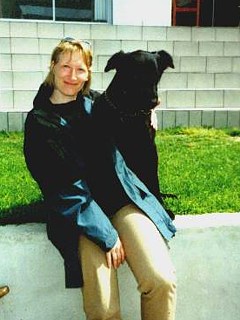
|
|
|
|
The Labrador and I |
|
|
Hints & Tips
Flying hours from and to London were
approx. 11 hours, totalling 14.5 hours Düsseldorf - Johannesburg and
17 hours Cape Town – Düsseldorf with connecting flights. At least
there was no time change. We made the reservations for September/October
as early as January, but even though this was 9 months in advance the cheapest
tickets were already gone!
In September/October 2002 petrol
in South Africa cost 0.42 euros per litre.
Tips in restaurants should be at
least 10%. For drinks we often ordered an Appletizer or Red or White Grapetizer
(sparkling apple or grape juice). You can drink the water and eat everything
without problems.
At the end of 2002 some towns, regions
and provinces in South Africa changed their names. Pretoria for example
will have an African name and be called Tshwane and Nelspruit Mbombela.
Others might change in the future.
To avoid disappointment reservations
at Kruger National Park should be made at least 6 months in advance. It’s
easy to book via the internet at
http://www.parks-sa.co.za.
It’s a good idea to bring along some
field glasses.
For our trip to Mexico in 2001 we
already got vaccination against Hepatitis A & B (Twinrix). After 3
shots within 6 months this will last us for 10 years. For South Africa
vaccination against tetanus, polio, diphtheria, hepatitis A, and for the
Kruger Park malaria prophylaxis, are highly recommended. For only a few
days in Kruger Park Malarone is the best and newest prophylaxis available.
One pill a day has to be taken 2 days before entering the malaria-risk
zone and continued until 7 days after departure.
An international driving license
is recommended and may be required.
We didn’t take along any traveller’s
checks as they would have been too bothersome. There are cash machines
on
every corner (in supermarkets and malls, at banks and petrol stations),
so we were best off with a credit card. Petrol has to be paid cash and
small B&Bs also prefer cash.
“En-suite” means a B&B room has
an adjoining bathroom.
Car doors should be kept locked at
all times and driving around in the dark should be avoided.
The infrastructure in South-Africa
is very similar to Europe or the US. Public transport is uncommon.
If you want to experience a part
of the real Africa, the Kruger Park is a must. In the south-west we mostly
enjoyed the Cape Penninsula, the De Hoop Nature Reserve with great whale-watching
opportunities, Tsitsikamma National Park and the Knysna region.
As a travel guidebook (in German)
I highly recommend “Reise Know-How Südafrika”.
Recommended Accommodation:
http://www.safarinow.com/homepage.aspx?spid=3065
(Britford House, Seapoint, Cape Town)
http://www.brendas.co.za/index.html
(Brenda’s Guest House, Green Point, Cape Town)
http://www.sirfrancis.co.za/
(Sir Francis, Green Point, Cape Town)
http://www.blue-orange.co.za (Blue Orange, Stellenbosch)
http://www.oldthatch.de
(Old Thatch Lodge, Swellendam)
http://www.squirrelscorner.co.za
(Squirrels Corner, Montagu)
http://www.hermanus.co.za/accom/stives
(St. Ives, Hermanus)
http://www.arniston.co.za/ (Arniston Lodge, Arniston)
http://www.fisheaglelodge.co.za/
(Fish Eagle Lodge, Knysna)
http://www.citylodge.co.za
(City Lodge, Johannesburg Airport)
http://www.linx.co.za/shamrockarms
(Shamrock Arms, Waterval Boven)
http://www.wayfarers.co.za/
(Wayfarers Guest House, Sabie)
http://www.villaticino.co.za
(Villa Ticino, Sabie)
http://www.satis.co.za/shingala/shingala.htm
(Shingala Guest House, Hazyview)

